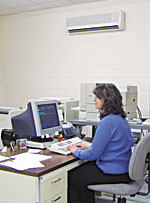
What's the major reason for this surge in interest? Flexibility, answered Lupton.
"Mini-splits are a great solution to a wide variety of installation challenges," Lupton explained, "giving contractors the ability to put air conditioning - and heat, with heat pump models - in locations that previously seemed impossible. And as awareness of the mini-split's advantages increases, new applications are being developed practically every day."
Basically, a mini-split does away with the need for ductwork. Like a regular split-system air conditioner or heat pump, the condenser is located outdoors; one or more air handlers are placed indoors. The two are connected by electrical and refrigerant lines that run through a small hole in an exterior wall, generally 3 inches in diameter or less.
Total Zone Control
In addition to eliminating the need for ducting, one of the other big advantages to mini-split systems is true zone control. The air handler is dedicated to the room being conditioned and is controlled by a wireless remote. That room can be kept at temperature and humidity levels that are different from the rest of the house or building.
Multiple-zone systems offering the same advantage are also available. In this type of an installation, the single condenser handles two or three air handlers. Each air handler is independently controlled, with its own remote and electronic-based climate controls to regulate temperature and humidity levels, as well as airflow. Units in a bedroom and a home office, for instance, can be programmed for different hours of operation with the 24-hour timer, or two classrooms situated side by side can be set at different temperatures.
Boundless Applications
Lupton said applications for ductless are "practically limitless," noting that ductless mini-splits were ideal for any place where installing ductwork is difficult, prohibitively expensive, or impractical. Residential and commercial applications are both candidates for mini-splits, whether they are new construction projects or existing buildings. Common applications, according to Lupton, include historic homes; vacation homes and cabins; schools; churches; nursing homes; residential room additions; remote offices, such as those inside a warehouse or factory; utility transfer stations; arena skyboxes; computer rooms; ATMs; and homes with hydronic heat.
In addition to preserving the exterior appearance of a building, mini-splits offer greater security than a window-mounted installation, since the only access to the interior is through a 3-inch hole. On the inside, air handlers are low profile at about 7 inches deep and neutral in color.
Quiet And Efficient
Another plus for mini-splits is that they are surprisingly quiet, according to Lupton. "Many people don't even realize they're running," he said.High-tech features can also make mini-splits inviting. Lupton said the tangential fan design on Heat Controller models moves large volumes of air at low fan speeds, resulting in reduced energy usage and operational sound. "A microprocessor continuously adjusts fan speed and louver direction for a gentle, breeze-like effect," he said.
From the contractors' perspective, it's nice to know that most mini-splits are easy to install, producing a better profit potential. The typical mini-split single-zone installation takes on average three to four hours, he said. With no ductwork to deal with and no time-consuming air balancing, installation can truly be called "fast and easy," he said, noting that it can often be done by a single person.
"Heat Controller is one of a few manufacturers that further simplifies installation through the use of low-voltage connections between the indoor and outdoor units," offered Lupton. "That means the electrician has to visit the site just once, to install an electrical box outside. In most cases, fuse disconnects or conduits inside the building aren't required, so the HVAC contractor can complete the job himself."
Lupton noted that local utility codes may differ and should always be observed. "Any job that's less complicated is less labor intensive, and that's usually good for the contractor's bottom line," said Lupton.
Shop Around
Making a buying decision can be confusing, said Lupton. "It's a good idea to shop around, to see what's available," said Lupton, adding that the decision should take into account several factors, not just price."Look at the company, its reputation, how long it's been in business," he advised. "Find out about parts availability, warranties, and after-the-sale support. Does the company have a technical hotline to help with installation questions and troubleshooting? Ask about inventory levels and shipping."
Publication date: 06/20/2005

Report Abusive Comment